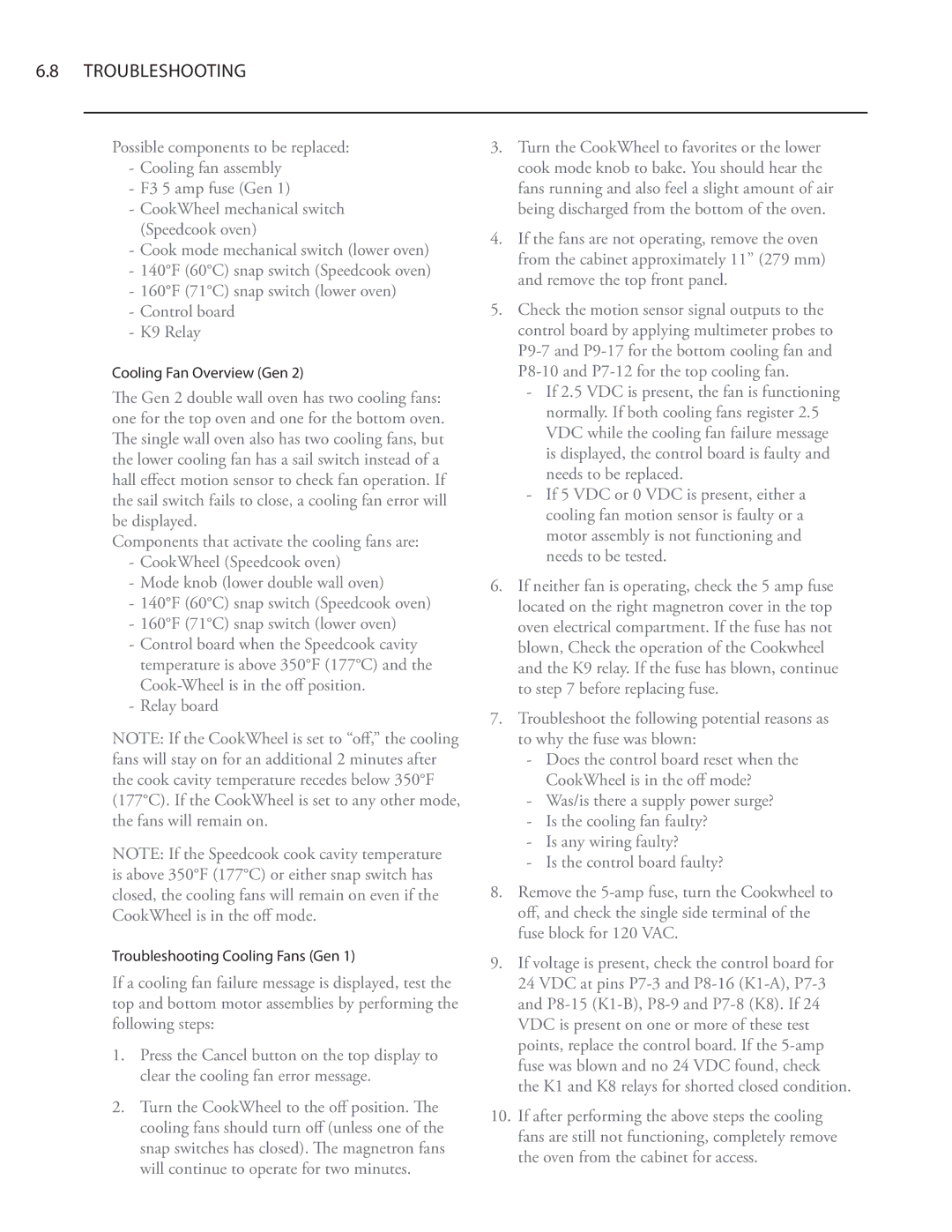6.8TROUBLESHOOTING
Possible components to be replaced:
-Cooling fan assembly
-F3 5 amp fuse (Gen 1)
-CookWheel mechanical switch (Speedcook oven)
-Cook mode mechanical switch (lower oven)
-140°F (60°C) snap switch (Speedcook oven)
-160°F (71°C) snap switch (lower oven)
-Control board
-K9 Relay
Cooling Fan Overview (Gen 2)
The Gen 2 double wall oven has two cooling fans: one for the top oven and one for the bottom oven. The single wall oven also has two cooling fans, but the lower cooling fan has a sail switch instead of a hall effect motion sensor to check fan operation. If the sail switch fails to close, a cooling fan error will be displayed.
Components that activate the cooling fans are:
-CookWheel (Speedcook oven)
-Mode knob (lower double wall oven)
-140°F (60°C) snap switch (Speedcook oven)
-160°F (71°C) snap switch (lower oven)
-Control board when the Speedcook cavity temperature is above 350°F (177°C) and the
-Relay board
NOTE: If the CookWheel is set to “off,” the cooling fans will stay on for an additional 2 minutes after the cook cavity temperature recedes below 350°F (177°C). If the CookWheel is set to any other mode, the fans will remain on.
NOTE: If the Speedcook cook cavity temperature is above 350°F (177°C) or either snap switch has closed, the cooling fans will remain on even if the CookWheel is in the off mode.
Troubleshooting Cooling Fans (Gen 1)
If a cooling fan failure message is displayed, test the top and bottom motor assemblies by performing the following steps:
1.Press the Cancel button on the top display to clear the cooling fan error message.
2.Turn the CookWheel to the off position. The cooling fans should turn off (unless one of the snap switches has closed). The magnetron fans will continue to operate for two minutes.
3.Turn the CookWheel to favorites or the lower cook mode knob to bake. You should hear the fans running and also feel a slight amount of air being discharged from the bottom of the oven.
4.If the fans are not operating, remove the oven from the cabinet approximately 11” (279 mm) and remove the top front panel.
5.Check the motion sensor signal outputs to the control board by applying multimeter probes to
-If 2.5 VDC is present, the fan is functioning normally. If both cooling fans register 2.5 VDC while the cooling fan failure message is displayed, the control board is faulty and needs to be replaced.
-If 5 VDC or 0 VDC is present, either a cooling fan motion sensor is faulty or a motor assembly is not functioning and needs to be tested.
6.If neither fan is operating, check the 5 amp fuse located on the right magnetron cover in the top oven electrical compartment. If the fuse has not blown, Check the operation of the Cookwheel and the K9 relay. If the fuse has blown, continue to step 7 before replacing fuse.
7.Troubleshoot the following potential reasons as to why the fuse was blown:
-Does the control board reset when the CookWheel is in the off mode?
-Was/is there a supply power surge?
-Is the cooling fan faulty?
-Is any wiring faulty?
-Is the control board faulty?
8.Remove the
9.If voltage is present, check the control board for 24 VDC at pins
10.If after performing the above steps the cooling fans are still not functioning, completely remove the oven from the cabinet for access.
